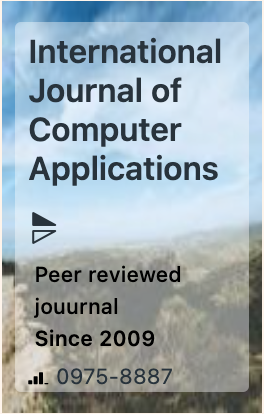The week's pick
Random Articles
Reseach Article
A Deep Learning-based Model for Traffic Signal Control using the YOLO Algorithm
| International Journal of Computer Applications |
| Foundation of Computer Science (FCS), NY, USA |
| Volume 186 - Number 63 |
| Year of Publication: 2025 |
| Authors: Oluwole Ayodeji Ayegbusi, Ayodeji Olusegun Akinwumi, OluwatosinLara Ogbeide, Alaba Olu Akingbesote, Joy Rotimi Obafemi, Olatunde David Akinrolabu, Odunayo Rotiba |
 10.5120/ijca2025924452
10.5120/ijca2025924452
|
Oluwole Ayodeji Ayegbusi, Ayodeji Olusegun Akinwumi, OluwatosinLara Ogbeide, Alaba Olu Akingbesote, Joy Rotimi Obafemi, Olatunde David Akinrolabu, Odunayo Rotiba . A Deep Learning-based Model for Traffic Signal Control using the YOLO Algorithm. International Journal of Computer Applications. 186, 63 ( Jan 2025), 43-54. DOI=10.5120/ijca2025924452
Abstract
With increasing urbanization and population growth, traffic congestion has become a significant challenge in cities, resulting in delays, excessive fuel consumption, pollution, and stress-related health issues. This problem stems from the imbalance between transportation demand and road infrastructure supply. Conventional methods, such as using the manual or fixed-time control systems, have proven inadequate as they fail to adapt to real-time traffic conditions. This research therefore introduces a deep learning-based smart traffic signal control model utilizing the YOLO (You Only Look Once) algorithm to mitigate traffic congestion in real time. The model captures live images from traffic junction cameras, detects vehicles, calculates traffic density, and dynamically adjusts signal timers, prioritizing lanes with higher traffic. The system’s architecture includes five phases: data acquisition, data pre-processing, training, signal control, and smart traffic control. The Open Images Dataset was utilized for the prototype demonstration, where the dataset was labeled and converted into a YOLO compatible format during the preprocessing phase to prepare it for training. The model was implemented using Python programming language. Evaluation revealed a 27% increase in traffic flow and a 50% reduction in vehicle waiting time. The research concluded that the YOLO based traffic control system provides a more effective solution to urban traffic congestion and is recommended for integration with CCTV cameras to facilitate efficient traffic management in cities.
References
- United Nations Department of Economic and Social Affairs, World Population Prospects 2022: Summary of Results, no. July. New York: United Nations, 2022. doi: 10.18356/cd7acf62-en.
- A. R. Goetz, “Transport challenges in rapidly growing cities: is there a magic bullet?,” Transp. Rev., vol. 39, no. 6, pp. 701–705, 2019, doi: 10.1080/01441647.2019.1654201.
- A. G. L. . Neto, M. L. Galves, O. F. L. Júnior, and D. Tacla, “Challenges of urban transport problems and city logistics: Sao Paulo city center case,” Urban Transp., vol. XIV, pp. 133–142, 2008, doi: 10.2495/UT080131.
- D. A. Duwaer, “On deep reinforcement learning for data-driven traffic control,” University of Technology, 2016. [Online]. Available: https://pure.tue.nl/ws/files/46945124/855429-1.pdf
- M. Gross, “A planet with two billion cars,” Curr. Biol., vol. 26, no. 8, pp. R307–R310, 2016, doi: 10.1016/j.cub.2016.04.019.
- X. Wang, R. Zeng, F. Zou, L. Liao, and F. Huang, “STTF : An Efficient Transformer Model for Traffic Congestion Prediction,” Int. J. Comput. Intell. Syst., vol. 16, no. 2, pp. 1–16, 2023, doi: 10.1007/s44196-022-00177-3.
- A. A. F. Al-sabaawi, “Traffic Congestion Control based In-Memory Analytics : Challenges and Advantages,” nternational J. Comput. Appl., vol. 170, no. 6, pp. 39–42, 2017.
- P. Sangaradasse and S. Eswari, “Importance of Traffic and Transportation Plan in the Context of Land Use Planning for Cities – A Review,” Int. J. Appl. Eng. Res., vol. 14, no. 9, pp. 2275–2281, 2019.
- C. Arti, G. Sharad, K. Pradeep, P. Chinmay, and S. S. Kumar, “Urban traffic congestion: its causes-consequences- mitigation,” Res. J. Chem. Environ., vol. 26, no. 12, pp. 164–176, 2022, doi: 10.25303/2612rjce1640176.
- R. Yu, Y. Zhang, L. Wang, and X. Du, “Time headway distribution analysis of naturalistic road users based on aerial datasets,” J. Intell. Connect. Veh., vol. 5, no. 3, pp. 149–156, 2022, doi: 10.1108/JICV-01-2022-0004.
- S. Rosenbloom, “Peak-period traffic congestion: A state-of-the-art analysis and evaluation of effective solutions,” Transportation (Amst)., vol. 7, no. 2, pp. 167–191, 1978, doi: 10.1007/BF00184638.
- N. Lanke and S. Koul, “Smart Traffic Management System,” Int. J. Comput. Appl., vol. 75, no. 7, pp. 19–22, 2013, doi: 10.5120/13123-0473.
- A. A. Obiri-yeboah, A. S. Amoah, and M. S. Gbeckor-kove, “Analysis of Congestion on Some Road Link Sections Using Roadside Friction in Congestion Index in Kumasi,” Int. J. Traffic Transp. Eng., vol. 10, no. 1, pp. 31–40, 2020, doi: 10.7708/ijtte.2020.10(1).03.
- A. Sharma, V. Madan, V. Bhargav, and N. Gulati, “Smart City Traffic Control System: A Literature Review,” in 14th International Conference on Cloud Computing, Data Science & Engineering (Confluence), 2024, pp. 36–40. doi: 10.1109/Confluence60223.2024.10463364.
- C. D. Higgins, M. N. Sweet, and P. S. Kanaroglou, “All minutes are not equal: travel time and the effects of congestion on commute satisfaction in Canadian cities,” Transportation (Amst)., vol. 45, no. 5, pp. 1249–1268, 2018, doi: 10.1007/s11116-017-9766-2.
- P. M. Evaluation, T. Congestion, U. Roads, A. Journal, and A. Sciences, “Evaluation of Traffic Congestion in an Urban Road: A Review,” ABUAD J. Eng. Appl. Sci., vol. 2, no. 2, pp. 1–7, 2024, doi: 10.53982/ajeas.2024.0202.01-j.
- S. Xu, C. Sun, and N. Liu, “Road congestion and air pollution -Analysis of spatial and temporal congestion effects,” Sci. Total Environ., vol. 945, no. 2024, p. 173896, 2024, doi: 10.1016/j.scitotenv.2024.173896.
- R. McConnell et al., “Childhood incident asthma and traffic-related air pollution at home and school,” Environ. Health Perspect., vol. 118, no. 7, pp. 1021–1026, 2010, doi: 10.1289/ehp.0901232.
- S. P. Mohanty, U. Choppali, and E. Kougianos, “Everything you wanted to know about smart cities,” IEEE Consumer Electronics Magazine, vol. 5, no. 3, pp. 60–70, 2016. doi: 10.1109/MCE.2016.2556879.
- J. O. Ukpata and A. A. Etika, “Traffic Congestion in Major Cities of Nigeria,” J. Eng. Technol., vol. 2, no. 8, pp. 1433–1438, 2012.
- M. Kanabe, “Traffic Congestion: Lagos to lose $ 21 billion monthly by 2030 – Expert,” PremiumTimes, 2022.
- K. Olagunju, “Evaluating Traffic Congestion in Developing Countries – A Case Study of Nigeria,” in 2015 Chartered Institute of Logistics and Transport (CILT) Africa Forum, 2015, pp. 1–28.
- J. O. Ukpata and A. A. Etika, “Traffic Congestion in Major Cities of Nigeria Traffic Congestion in Major Cities of Nigeria,” Int. J. Eng. Technol., vol. 2, no. 8, pp. 1433–1438, 2012.
- R. A. Olawepo, Y. A. Ahmed, and A. Asaju, “Planning For Sustainability: Transportation and Land Use in Ilorin, Nigeria,” J. Art, Archit. Built Environ., vol. 3, no. 2, pp. 18–30, 2020, doi: 10.32350/jaabe.32.02.
- G. C. Oweisana and V. N. Ordua, “Influence of Traffic Congestion on Psychological Stress and Pro-Social Behaviour among Commuters in Port-Harcourt Metropolis,” Nnamdi Azikwe Journals, pp. 1–15, 2022.
- D. Stokols and R. W. Novaco, “Traffic Congestion, Type A Behavior and Stress,” J. f Appl. Psychol., vol. 63, no. 4, pp. 467–480, 1978, doi: 10.1037/0021-9010.63.4.467.
- A. O. Awosusi and I. . Akindutire, “Urban Traffic Congestion and Its Attendant Health Effects,” An Int. Multi-Disciplinary J., vol. 4, no. 17, pp. 434–446, 2010.
- C. E. Ojieabu, “Developed Automated Vehicle Traffic Light Controller System for Cities in Nigeria,” J. Adv. Sci. Eng., vol. 1, no. 1, pp. 19–25, 2018, doi: 10.37121/jase.v1i1.6.
- A. Jibrin, “Design and Simulation of an Intelligent Road Traffic Control System,” Eng. Res. J., vol. 2, no. 11, pp. 1–17, 2022.
- L. I. Igbinosun and O. Izevbizua, “Some control strategies for road traffic flow in Nigeria,” Int. J. Stat. Appl. Math., vol. 5, no. 4, pp. 56–61, 2020, [Online]. Available: www.dft.gov.uk/traffic-count/.
- D. B. O. Prince and O. Desmond, “Occupational Hazards Associated with Traffic Warden in Port Harcourt Metropolis, Rivers State, Nigeria.,” Asian J. Res. Nurs. Heal., vol. 5, no. 1, pp. 203–216, 20225.
- I. Rasdi, N. F. Din, N. Roni, A. S. Nizam, and I. Isa, “Fatigue Among Traffic Police Officers in Metropolitan City: Exploring Factors of Noise Exposure and Work Stressors,” Malaysian J. Med. Heal. Sci., vol. 16, no. Supp 11, pp. 109–117, 2020.
- G. P. Felicio, L. C. Grepo, V. F. Reyes, and L. C. Yupingkun, “Traffic Light Displays and Driver Behaviors: A Case Study,” Procedia Manuf., vol. 3, no. 2015, pp. 3266–3273, 2015, doi: 10.1016/j.promfg.2015.07.879.
- Department for Transport UK, “Highway Code: Light signals controlling traffic,” The Highway Code. Accessed: Dec. 19, 2024. [Online]. Available: https://assets.publishing.service.gov.uk/media/560aa3f9e5274a036900001c/the-highway-code-light-signals-controlling-traffic.pdf
- Q. F. Zhou and J. Yang, “Design and Implementation of Traffic Lights Control System Based on FPGA,” in Proceedings of the International Conference on Chemical, Material and Food Engineering, 2015, pp. 822–825. doi: 10.2991/cmfe-15.2015.195.
- N. Tsalikidis, A. Mystakidis, P. Koukaras, M. Ivaškeviˇ, D. Ioannidis, and C. Tjortjis, “smart cities Urban Traffic Congestion Prediction : A Multi-Step Approach Utilizing Sensor Data and Weather Information,” Smart Cities, vol. 7, pp. 233–253, 2024, doi: 10.3390/smartcities7010010.
- A. Amin, S. Bahnasy, A. Elhadidy, and M. Elattar, “Real-time 4-way Intersection Smart Traffic Control System,” 2nd Nov. Intell. Lead. Emerg. Sci. Conf. NILES 2020, pp. 428–433, 2020, doi: 10.1109/NILES50944.2020.9257949.
- R. Chauhan, K. K. Ghanshala, and R. . Josh, “Convolutional Neural Network ( CNN ) for Image Detection and Recognition,” in 2018 First International Conference on Secure Cyber Computing and Communication (ICSCCC), IEEE, 2018, pp. 278–282. doi: 10.1109/ICSCCC.2018.8703316.
- S. Indolia, A. K. Goswami, S. P. Mishra, and P. Asopa, “Conceptual Understanding of Convolutional Neural Network- A Deep Learning Approach,” Procedia Comput. Sci., vol. 132, pp. 679–688, 2018, doi: 10.1016/j.procs.2018.05.069.
- A. O. Ige and M. H. M. Noor, “A lightweight deep learning with feature weighting for activity recognition,” Comput. Intell., vol. 39, no. 2, pp. 315–343, 2022, doi: https://doi.org/10.1111/coin.12565.
- Z. Sun, “Pattern Recognition in Convolutional Neural Network (CNN),” Appl. Intell. Syst. Multi-modal Inf. Anal., vol. 138, pp. 295–302, 2022.
- A. O. Akinwumi, A. O. Akingbesote, O. O. Ajayi, and F. O. Aranuwa, “Detection of Distributed Denial of Service (DDoS) attacks using convolutional neural networks,” Niger. J. Technol., vol. 41, no. 6, pp. 1017–1024, 2022, doi: 10.4314/njt.v41i6.12.
- H. M. Z. Haque, “Aortic Valve Segmentation using Convolutional Neural Network with Skip Mechanism,” Commun. Appl. Electron., vol. 7, no. 29, pp. 1–5, 2019.
- F. O. Aranuwa and O. B. Fawehinmi, “Classification Model For Iris Images Using Convolutional Neural Network ( CNN ),” in Proceedings of the 32nd Accra Multidisciplinary Cross-Border Conference (AMCBC), Accra, 2022, pp. 7–22.
- C. Szegedy, A. Toshev, and D. Erhan, “Deep Neural Networks for Object Detection,” Adv. neural Inf. Process. Syst., pp. 2553–2561, 2013, doi: 10.3928/19404921-20140820-01.
- Y. Zhang et al., “Towards end-to-end speech recognition with deep convolutional neural networks,” Proc. Annu. Conf. Int. Speech Commun. Assoc. INTERSPEECH, vol. 08-12-Sept, no. September, pp. 410–414, 2016, doi: 10.21437/Interspeech.2016-1446.
- D. Issa, M. Fatih Demirci, and A. Yazici, “Speech emotion recognition with deep convolutional neural networks,” Biomed. Signal Process. Control, vol. 59, p. 101894, 2020, doi: 10.1016/j.bspc.2020.101894.
- X. Luo, R. Shen, J. Hu, J. Deng, L. Hu, and Q. Guan, “A Deep Convolution Neural Network Model for Vehicle Recognition and Face Recognition,” Procedia Comput. Sci., vol. 107, no. Icict, pp. 715–720, 2017, doi: 10.1016/j.procs.2017.03.153.
- A. Ucar, “Deep Convolutional Neural Networks for facial expression recognition,” Proc. - 2017 IEEE Int. Conf. Innov. Intell. Syst. Appl. INISTA 2017, pp. 371–375, 2017, doi: 10.1109/INISTA.2017.8001188.
- A. E. Ebitigha, O. O. Ajayi, O. D. Akinrolabu, A. Adegbite, J. Obafemi, and J. K. Ogunleye, “Facial Appearance Analysis for Age Group Prediction Using Convolutional Neural Network,” in International Conference on Science, Engineering and Business for Driving Sustainable Development Goals, 2024.
- A. O. Akinwumi, A. O. Ige, J. R. Obafemi, O. D. Akinrolabu, and B. O. Akingbesote, “CBDS-ConvNet : A Cyber-Bullying Detection Model using Convolutional Neural Network,” Commun. Appl. Electron., vol. 7, no. 40, pp. 11–21, 2025, doi: 10.5120/cae2025652905.
- J. Natarajan, W. Wang, Y. Jiang, Z. Zhang, H. Ye, and L. Kuang, “Generative-CNN for Pattern Recognition in Finance,” in ICAIF 2024 - 5th ACM International Conference on AI in Finance, 2024, pp. 142–149. doi: 10.1145/3677052.3698622.
- A. Dibouliya and V. Jotwani, “Traffic Density Monitoring Control System Using Convolution Neural Network,” Int. J. Sci. Res. Eng. Dev., vol. 6, no. 5, pp. 31–39, 2024, [Online]. Available: www.ijsred.com
- J. Redmon, S. Divvala, R. Girshick, and A. Farhadi, “You Only Look Once: Unified, Real-Time Object Detection,” in IEEE Conference on Computer Vision and Pattern Recognition (CVPR), 2016, p. 788. doi: 10.1145/3243394.3243692.
- S. Gothane, “A Practice for Object Detection Using YOLO Algorithm,” Int. J. Sci. Res. Comput. Sci. Eng. Inf. Technol., vol. 7, no. 2, pp. 268–272, 2021, doi: 10.32628/cseit217249.
- V. Viswanatha, R. Chandana, and A. C. Ramachandra, “Real Time Object Detection System with YOLO and CNN Models: A Review,” vol. XIV, no. 7, pp. 144–151, 2022, [Online]. Available: http://arxiv.org/abs/2208.00773
- R. Cheng, “A survey: Comparison between Convolutional Neural Network and YOLO in image identification,” in Journal of Physics: Conference Series, 2019, p. 012139. doi: 10.1088/1742-6596/1453/1/012139.
- P. Kunekar, Y. Narule, R. Mahajan, S. Mandlapure, and E. Mehendale, “Traffic Management System Using YOLO Algorithm,” in Engineering Proceedings, 2023, p. 210.
- A. S. Salama, B. K. Saleh, and M. M. Eassa, “Intelligent cross road traffic management system (ICRTMS),” ICCTD 2010 - 2010 2nd Int. Conf. Comput. Technol. Dev. Proc., no. Icctd, pp. 27–31, 2010, doi: 10.1109/ICCTD.2010.5646059.
- V. Samhita, S. Prachi, A. Rajesh, and P. Aparna, “Intelligent Traffic Density Monitoring Using RFID,” no. March, 2018.
- A. Yadav, V. More, N. Shinde, M. Nerurkar, and N. Sakhare, “Adaptive Traffic Management System Using IoT and Machine Learning,” Int. J. Sci. Res. Sci. Eng. Technol., no. January, pp. 216–229, 2019, doi: 10.32628/ijsrset196146.
- O. L. Ogbeide, O. Olabode, A. Oluwatoyin, and O. Boyinbode, “Deep Sarsa Replay model for real Time Traffic Control,” Int. J. Adv. Eng. Manag., vol. 6, no. 11, pp. 398–408, 2024, doi: 10.35629/5252-0611398408.
- A. M. Miyim and M. A. Muhammed, “Smart traffic management system using Arduino and RFID Tags,” 2019 15th Int. Conf. Electron. Comput. Comput. ICECCO 2019, vol. 6, no. 2, pp. 377–383, 2019, doi: 10.1109/ICECCO48375.2019.9043219.
- M. A. Khan, H. Park, and J. Chae, “A Lightweight Convolutional Neural Network (CNN) Architecture for Traffic Sign Recognition in Urban Road Networks,” Electron., vol. 12, no. 8, 2023, doi: 10.3390/electronics12081802.
- Khusi, “Smart Control of Traffic Light System using Image Processing,” in International Conference on Current Trends in Computer, Electrical, Electronics and Communication (ICCTCEEC-2017), 2017, pp. 99–103.
Index Terms
Keywords

